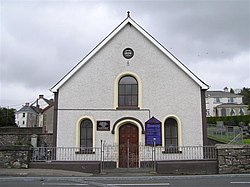Pomeroy, Tyrone
| Pomeroy | |
| Tyrone | |
|---|---|
 Pomeroy Presbyterian Church | |
| Location | |
| Grid reference: | H694723 |
| Location: | 54°35’39"N, 6°55’37"W |
| Data | |
| Population: | 788 (2011) |
| Post town: | Dungannon |
| Postcode: | BT70 |
| Dialling code: | 028 |
| Local Government | |
| Council: | Mid-Ulster |
Pomeroy is a small village in Tyrone. It is in the townland of Cavanakeeran, eight and a half miles from Cookstown, nine miles from Dungannon and sixteen miles from Omagh. The 2011 Census recorded a population of 788 people.
Pomeroy is atop a large hill that dominates the surrounding countryside. From the Cookstown end, the road through the village gradually climbs a gradient up to a village square, The Diamond. The village is surrounded by the Pomeroy Hills. The surrounding countryside is a mixture of moorland and bog land. Stone Age and Bronze Age cairns dot the landscape. Pomeroy is the closest settlement to the geographical centre of Ulster.[1]
History
At the end of the 17th century there was no village in this area; just an extensive forest. In the Plantation of Ulster, King James I and VI granted eight townlands to Sir William Parsons, Surveyor General of Ireland. In 1729 James Lowry inherited the land from his father, Robert of Aghenis Caledon.
In the 18th century two new parishes were created in Tyrone, and the same family, the Lowrys (from whom issued the Earls of Belmore), was involved in the establishment of both. Pomeroy was created from part of Donaghmore, while Clogherny was taken from Termonmaguirc. The arrangement was confirmed in 1731 by an Order in Council, and the articles of agreement under which it was conducted by the two parties involved, Lord Tyrone and Robert Lowry, suggest the tone:
The name of each of the new erected parishes shall be wrote on a separate scrole of parchment, roll'd up and put into a hatt, to be held by an indeffernet person,... and that the said Marcus, Lord Viscount of Tyrone, and Robert Lowry shall each put his hand into the said hatt, and take thereout one of the said scroles, and that the advowson of that parish which shall be mentioned in the said scrole .. to be drawn out of the said hatte, by the said Lord Tyrone, shall stand and be the advowson of the said .. Tyrone, his heirs and assigns, for ever."
In 1750 Rev. James Lowry was granted the right to hold a weekly market in Pomeroy and an important event was the twice yearly Hiring Fair, held in May and November. Men and women from the surrounding countryside would gather at the fair and hire themselves out as farm workers and servants. In the 1640s the large forest had been stripped of timber and for many years after remained neglected. In 1770 the Rev. James Lowry undertook its management, replanted about 556 acres and left money to build Pomeroy House. The Lowry family played a big part in the life of the area for about 200 years.
In the square is the Church of Ireland church which dates from the early 1840s. Its belfry and tower were paid for by the Lowry family as a token of their esteem for Pomeroy.
Much of the woodland is gone and the Georgian mansion demolished. All that remains is the family burial vault on Tanderagee Road. This was once approached by the longest avenue of Chilean pine trees in Ireland.
The road leading from Pomeroy to Donaghmore is known as the Royal Road because in 1689 the deposed King James II and VII took this route to visit his troops outside Londonderry during the historic siege. This route brought him through Cappagh and Altmore. King James's Well is by the roadside just outside Cappagh.
Railway
The Portadown, Dungannon and Omagh Junction Railway opened Pomeroy railway station on 2 September 1861. From 1876 until 1958 it was part of the Great Northern Railway. The Ulster Transport Authority closed the station and the PD&O line on 15 February 1965.[2] Throughout its history it had the highest altitude of any Irish gauge railway station on the island of Ireland. West of Pomeroy the railway reached its summit, 561 feet above sea level,[3] the highest point on Ireland's Irish gauge network.
About the village
| ("Wikimedia Commons" has material about Pomeroy, Tyrone) |
- There is a modern forestry school on the estate of the Rev. James Lowry, the 18th century planner of the village.
- Mountains of Pomeroy
- Carrickmore
- Altmore
- Gortavoy Bridge
- Cavanakeeran
References
- ↑ "Ireland Geographical Facts, Figures and Physical Extremities". http://www.wesleyjohnston.com/users/ireland/geography/extremities.html.
- ↑ "Pomeroy station". Railscot - Irish Railways. http://www.railscot.co.uk/Ireland/Irish_railways.pdf.
- ↑ Hajducki, S. Maxwell (1974). A Railway Atlas of Ireland. Newton Abbott: David & Charles. map 8. ISBN 0-7153-5167-2.
